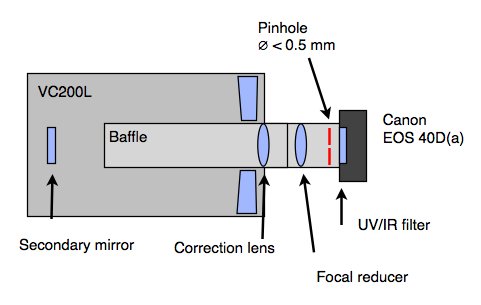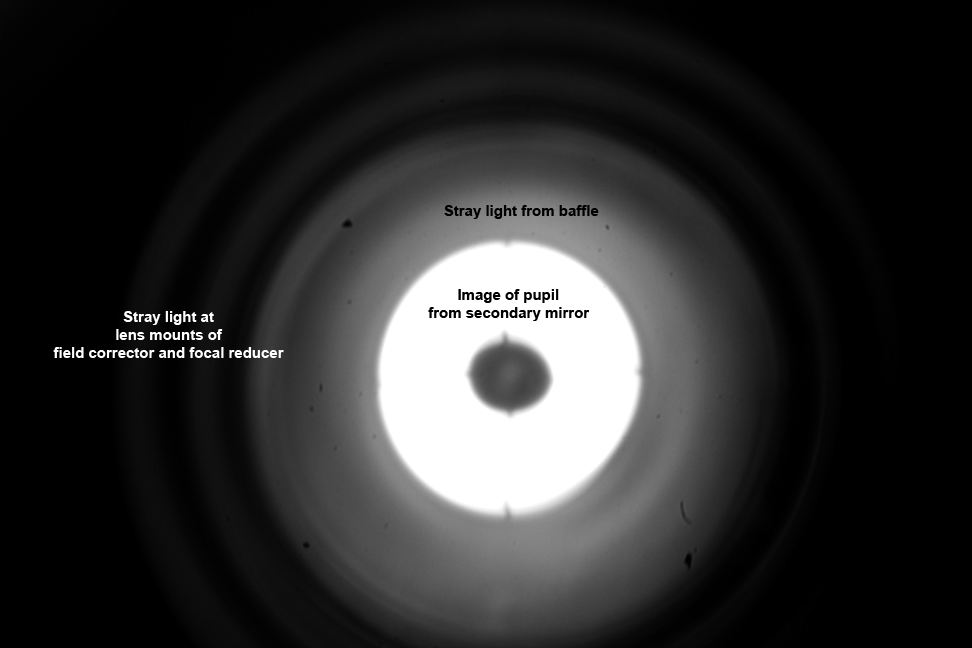Professional astronomers and amateur astrophotographers certainly are aware of a common problem with deep-sky imagery: Certain residuals from the bright night sky will persist as bright background illumination, possibly with certain gradient in the image. This often remains true, if dark and flatfield calibration are accurately performed. What will cause this problem?
Fig. 1: Image of M13 taken two days before full moon. The result shows strong background illumination and a certain color gradient. Click to enlarge.
The description presented from the observers websites often will not yield any reason for the failure of the flatfield calibration task. Maybe, observers fear, that somebody would blame them for writing down every observation condition like: "Image taken at full moon". Although it would be nice to get more details about observations from the observers, true observing conditions and reasons given for the breakdown of a flatfield task are left out and remain as a pure speculation.
The major reasons for a persistent background illumination with or without certain (color) gradient are: (1) Suburban sky illumination and (2) stray light from light sources like the bright moon or a street lamp. The gradient from the illuminated night sky is neglectible in deep-sky images from larger telescopes, because the field of view usually is found in the order of one angular degree or less with a digital detector and focal length of more than 1.000 mm. Therefore, stray light remains as the major source of pain.
Observations
Grundahl & Sorensen (1996) published a method for the detection of scattered light from astronomical telescopes. The idea sounds funny and is very simple: Place a pinhole in front of your CCD or DSLR camera and take some pictures from the sky at daylight. This method was applied to check for scattered light, that will occur inside the Vixen VC200L used for the observations. The image below demonstrates the simple trick:
Fig. 2: Schematic view of the pinwhole camera used with the VC200L and DSLR camera. A plastic or aluminum chip with a pinhole is placed in the objective mount in front of the camera and filter. Click to enlarge.
A piece of black opaque plastic is cut out round to be placed in from of the camera body. Using a thin needle a small pinhole is pierced into the center of the chip. A chip of aluminum foil cut out round will perform as well, however. The pinhole chip shall be safely placed in front of the CCD camera or DSLR camera and outside the body (in front of an Astronomik EOS clip filter, that is inserted into the camera body in my case). Do not place the chip inside the body of your DSLR camera, because it may harm or destroy the shutter of the camera! This certainly would result in an expensive repair of a broken camera. From an exposure series, the best exposure time will be evaluated. The best exposure for this observation yielded 5 seconds. However, exposure time will depend on the size of the pinhole and amount of straylight. From the exposure the sources of scattered light are easily identified from the image shown in Fig. 3.
Fig. 3: Result from the pinhole camera with the VC200L and DSLR camera setup. Click to enlarge.
From the image obtained, one finds typical sources of scattered light, which will occur in the baffle of the Cassegrain telescope. The stray light is introduced from the painting of the baffle. Stray light is also introduced from the lens mounts of the field corrector and focal reducer of the Cassegrain telescope.
From the deep sky image shown in Fig. 1, stray light from the baffle is found offset from the optical axis with a certain gradient. Obviously, this is caused by the bright moon at the night of observation. The bright moon will produce certain oblique illumination and causes some gradient from an inhomogeneous distribution of stray light in the tube. Therefore, and because the field of view is only one angular degree, this is not caused by a gradient of the sky illumination. Instead, the background illumination is caused by light falling tilted into the tube of the telescope optics, where it is reflected and scattered at the painting of the tube and baffle.
Consequences
Not only Cassegrain telescopes suffer from scattered light. Stray light is also found from the optical path inside lens telescopes or Newton telescope designs as well. The scattered light can be reduced by insertion of certain rings inside the tube and baffle to block the light, that is totally reflected at the inner painting. As it is seen in Fig. 1, even matt varnish of the inner tube walls will reflect enough light to introduce certain background light pollution. Depending on the construction of the telescope and accessories in the optical path, like correction lenses or filters, sources of stray light are individually different and shall be evaluated by experiments. From the use of broad-band filters, sometimes there is also some light found reflected back into the tube and optics of the telescope where it may produce scattered light which depends on the filter currently used with the telescope and detector.
What follows is crucial to the flatfield calibration: A simple division of the flatfield, as it is proposed by Gilliland (1992), will not work in many cases. Why?
The Answer is simple. If one takes pictures of the flat field from the sky or some dome flatfield, one shall not expect, that a simple division of the flatfield will work to correct for vignetting and local variations of the pixel response of the detector. The flatfield recorded also suffers from light pollution caused by stray light. This means, the recorded flat field is a sum of a multiplicative term and a certain additive background illumination from scattered light. The latter depends heavily on the source of the flat field, either sky or artificial illumination. Further effects, that will affect the success of the flatfield process, are the correct focus (how to focus a homogeneous illumination?) and the distance of the light source used to be recorded as a flat field. A dome flatfield will yield different results compared to the use of a sky flatfield.
One shall think about elimination of scattered light in the telescope. And one shall think over the kind of flatfield correction of astronomical images. Both methods will heavily affect the accuracy of photometric measures at the limiting magnitude and field distribution of magnitudes found in an astronomical image. A common trick used by many professional astronomers and amateur astrophotographers is to evaluate the flat field from the sky background of the astronomical image itself. This evaluation of a flat field from the deep-sky image itself also won't work. If strong background illumination with certain gradient is found after the flat field calibration, one shall not expect, that using the background illumination as a flatfield divisor will yield good photometric results! The contribution of scattered light is additive or showing more complexity, than a simple division would correct, as it is proposed by Gilliland (1992). Finally, a wrong flatfield calibration will definitively harm any photometric measures from stars located in the field of view.
Conclusion
Gilliland (1992) and other authors introduced the concept of the flatfield task to digital imaging in astronomy. On the other hand, there remains the question, how to obtain a measure of quality of success to the application of the flatfield task with any given telescope and camera. If one will not find additive background illumination or gradients in the background anymore, this will not mean, that the process of flatfield calibration has been applied successfully in terms of an enhancement of the photometric accuracy. It only means: We do not see the scattered light anymore! Instead, this possibly may have introduced a certain gradient to the flat field to obscure the scattered light. In this case the absolute errors of photometry are harmed depending on the position of the stars in the field, which means: The task of flatfield is misleading in case of having found scattered light within the astronomical imagery. The finding of a good solution to this problem still is left an open question.
References:
Gilliland R. L., 1992, in Howell S. B., ed., Astronomical CCD observing and reduction techniques. Details of Noise Sources and Reduction Processes. Astronomical Society of the Pacific, San Francisco, CA, p. 68
Grundahl, F.; Sorensen, A. N., 1996. Detection of scattered light in telescopes. Astronomy and Astrophysics Supplement, v.116, p.367-371.



